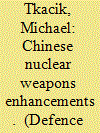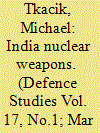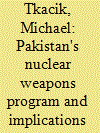|
|
|
Sort Order |
|
|
|
Items / Page
|
|
|
|
|
|
|
| Srl | Item |
| 1 |
ID:
129957


|
|
|
|
|
| Publication |
2014.
|
| Summary/Abstract |
Mainstream analysis of China's nuclear weapons program sees the current buildup as restrained and driven by American counterforce capabilities (both conventional and nuclear). This reflects an assumption by such analysts that PRC strategists share assumptions with Western analysts about the disutility of nuclear weapons. This manuscript presents an alternative interpretation of China's current nuclear modernization. The article examines the capabilities being acquired by the PRC, including rapid response, MIRVs, and highly survivable delivery systems. The paper argues it is equally plausible that China seeks warfighting capabilities and that will be useful in political coercion as it transitions to an international hegemon.
|
|
|
|
|
|
|
|
|
|
|
|
|
|
|
|
| 2 |
ID:
175670


|
|
|
|
|
| Summary/Abstract |
This article examines the roles of nationalism, the historical case of World War One, and the Cult of the Offensive in explaining the growing conflict in the South China Sea. The article pays greatest attention to China and the United States in their respective roles as rising great power and hegemon. The article posits that nationalism may be dangerously out of control in China today. It critically examines those arguments claiming the World War One analogy is inappropriate, and concludes the “Great War” holds both applicable and inapplicable lessons. Finally, the article examines the Cult of the Offensive and argues this lens is particularly helpful in understanding the drive to conflict in the South China Sea.
|
|
|
|
|
|
|
|
|
|
|
|
|
|
|
|
| 3 |
ID:
151398


|
|
|
|
|
| Summary/Abstract |
This article argues India is laying the foundation to move away from “no-first-use” (NFU) as its nuclear weapons employment policy. Since the inception of its nuclear weapons program, India has claimed NFU as the centerpiece of its nuclear strategy. But India has a history of developing foundational changes to its nuclear weapons program before such changes actually occur. For example, the infrastructure of India’s nuclear weapons program was already being created in the 1950s under the guise of civilian nuclear power. Similarly, the weaponization of India’s program, which did not officially occur until after the 1998 tests, had its genesis in far earlier decisions. A close examination of trends in India’s nuclear weapons production complex, its delivery systems, and its command and control complex all lead to the conclusion that India is laying the groundwork for more flexible employment options, up to and including first use. This article does not argue such a decision has been taken. Rather, it argues the underpinning is in place to allow for a move to more flexible options, perhaps very quickly, at some point in the future. This could occur during crisis or it could occur incrementally over time.
|
|
|
|
|
|
|
|
|
|
|
|
|
|
|
|
| 4 |
ID:
097807


|
|
|
|
|
| Publication |
2010.
|
| Summary/Abstract |
This article analyzes Pakistan's nuclear weapons program and the characteristics of the environment in which the program is nested. These characteristics include Pakistan's history of internal and external instability; nuclear saber-rattling during crises; support for Islamic terrorism in order to advance state goals; indigenous production of many elements of its nuclear forces; possession of delivery and command and control systems with destabilizing characteristics; and, finally, nuclear doctrine that appears to advocate first use of nuclear weapons. The article argues that the characteristics of Pakistan's nuclear weapons program generate threats to US national security interests. The article examines six interrelated and synergistic challenges for US national security: first, Pakistan is engaged in an arms race in Southwest Asia that has negative implications for Pakistan's stability; second, the threat of nuclear proliferation from Pakistan continues; third, Pakistan's arsenal characteristics make accidental and/or unauthorized nuclear war more likely; fourth, there is an ongoing possibility of war with India; fifth, Islamist influence is spreading through key sectors of Pakistani society; and, finally, there is an increasing danger of state failure in Pakistan.
|
|
|
|
|
|
|
|
|
|
|
|
|
|
|
|
| 5 |
ID:
163092


|
|
|
|
|
| Summary/Abstract |
The slow moving conflict in the South China Sea has been characterized by some as “not worth the candle.” China claims the entirety of the South China Sea pursuant to a nine-dash line, the legal impact of which has been limited by international courts. At the same time, China has changed the reality of control over the South China Sea by building a number of fortified islands in the Spratly Islands and elsewhere. The US has either refused to stand up to China's behavior (Obama) or responded unevenly (Trump). This paper examines the impact of China's behaviour on local parties, US interests, and the liberal international system.
|
|
|
|
|
|
|
|
|
|
|
|
|
|
|
|
|
|
|
|
|